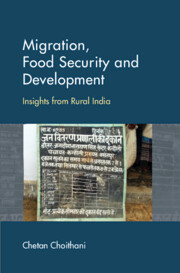Book contents
- Frontmatter
- Contents
- List of Figures, Tables and Boxes
- List of Photos
- Preface
- Acknowledgements
- List of Abbreviations
- 1 Introduction
- 2 Bridging the Disconnect between Migration and Food Security
- 3 Dynamics of Food Insecurity, Migration and Urbanisation in India
- 4 The Context of Migration
- 5 Connections between Food Safety Nets and Migration
- 6 Migration, Remittances, Land and Household Food Security
- 7 Opening the Household Box
- 8 Conclusion
- References
- Index
5 - Connections between Food Safety Nets and Migration
Published online by Cambridge University Press: 22 February 2023
- Frontmatter
- Contents
- List of Figures, Tables and Boxes
- List of Photos
- Preface
- Acknowledgements
- List of Abbreviations
- 1 Introduction
- 2 Bridging the Disconnect between Migration and Food Security
- 3 Dynamics of Food Insecurity, Migration and Urbanisation in India
- 4 The Context of Migration
- 5 Connections between Food Safety Nets and Migration
- 6 Migration, Remittances, Land and Household Food Security
- 7 Opening the Household Box
- 8 Conclusion
- References
- Index
Summary
INTRODUCTION
A key issue facing a large majority of India's vulnerable rural populations is their inability to avail the benefits of state-assisted social protection schemes. Although public expenditure on social protection in India remains notoriously low compared to many other countries at similar stages of economic development (Dreze and Sen, 2013), numerous public assistance programmes – both in-kind and cash-income support – currently exist with the purpose of providing some form of social protection to the poor and vulnerable. Because of the exclusionary nature of economic growth in India in the post-liberalisation period, which has widened the gap between the haves and have-nots, the cause of strengthening social protection has been given further impetus in recent years. This is reflected in the dominant narrative of inclusive development that has come to characterise social and economic development policy thinking in India in the recent past. Social protection forms an integral feature of this broad-based vision of the development trajectory.
With India having among the worst food and nutritional indicators in the world, not coincidentally a major thrust of social protection policy in recent years has been on food-based safety nets, particularly for rural populations. It is important to note that the country has a long history of running an extensive set of food-based safety nets. For example, the PDS that provides subsidised food rations to poor families has been in place since the late 1960s. Yet, unlike earlier times, policy considerations of food security are now based on the recognition of the right to food. A landmark event in this regard is the passage of the NFSA in 2013, which enshrines the constitutional right to food for poor and vulnerable population groups (Government of India, 2013a). Thus, no longer is food security a matter of public policy discretion; instead, the state is now legally obligated to ensure that the minimum food needs of the poor and vulnerable are met.
The three major food-based safety net programmes in India are the PDS, the NREGS and the ICDS. The aim of this chapter is to review these interventions and ask how they interact with household food security and migration, the two core social processes at the heart of this book.
- Type
- Chapter
- Information
- Migration, Food Security and DevelopmentInsights from Rural India, pp. 132 - 180Publisher: Cambridge University PressPrint publication year: 2023



